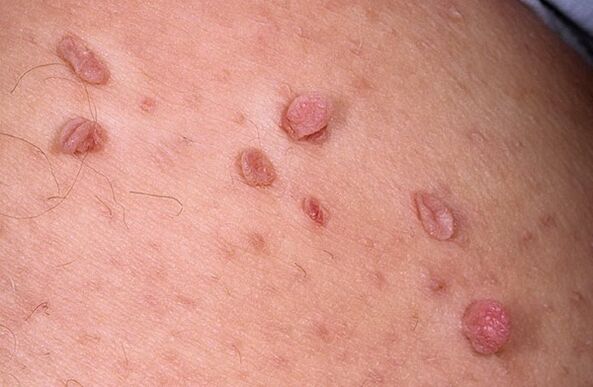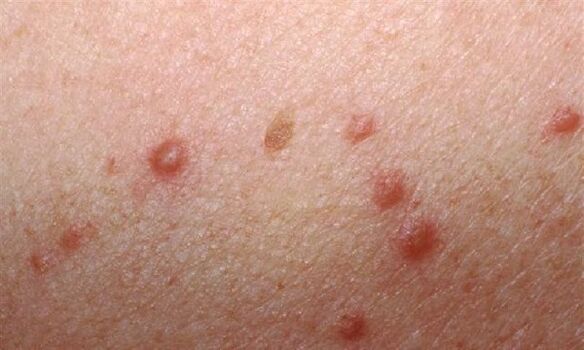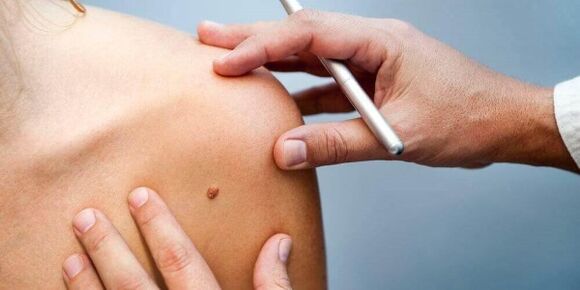The causes of papillomas on the body surface in women in most cases are associated with infection of the body with the papillomatosis virus. There is also an innate formation that is transmitted along with genetic information from one of the parents.
What is a papilloma?
Papilloma is a benign neoplasm of the female body, the cause of which is the pathogenic activity of viral microorganisms of the papillomavirus family. Translated from Latin means "papillo - nipple" and "oma - a typical ending for all types of tumors. "
Papillomas are formed from the host's own epithelial cells. Outwardly, it looks like a connecting papilla with a flat, sharp, round or branched shape.
A distinctive feature of benign neoplasms of this type is that they are able to develop on the mucous membranes of the oral cavity, internal organs with hollow structures, inside the nostrils, nasal sinuses, on the vocal cords.
Initially, papilloma roots are formed from squamous epithelium with gradual growth over the generalized skin.

Tumor color can range from fleshy to brown and pink. . . Localization of papillomas within the bladder, intestines, organs of the respiratory system can lead to the development of the disease and its accompanying complications.
Types of papillomas on the body in women
Depending on the location of the warts, their appearance and the reasons that led to their formation, different types of papillomas are distinguished. The table below lists the types of benign neoplasms of this type, indicating their features.
| Papilloma type | Features of neoplasms |
|---|---|
| Genital warts | They can be found in any part of the female body. Outwardly, they look like oblong hanging moles, which in most cases have a brown tint. |
| Papilloma vulgaris | The classic form of the manifestation of the human papillomatosis virus. Neoplasms are spherical, they are attached to the main surface of the body on thin and short stalks. Is the flesh colored like the rest of the dermis. |
| Genital warts | The localization of this type of neoplasm is the intimate zone in both men and women. Infection occurs as a result of unprotected sexual intercourse with an infected partner. The primary sites of tumors are the anal circumference, the labia majora and minora in women, and the foreskin in men. If sanitary and hygienic standards are not complied with, household contamination is possible. |
| senile warts | Found in older women. They appear as a result of hormonal changes in the body, metabolic disorders, prolonged exposure to the sun. The main danger of this type of papilloma is the high risk of their degeneration into a malignant neoplasm. |
| Plantar | This type of papilloma is localized exclusively in the area of the plantar part of the foot. Outwardly, they resemble small heads of cauliflower with branched inflorescences. If a woman walks a lot, wears tight shoes, plantar warts can become inflamed, bleed and cause pain. |
Almost all of the above types of papilloma are formed as a result of infection of a woman with one or more genotypes of the human papillomavirus. The only exception is senile warts, which can appear due to age-related changes in the body of the elderly.
Stages and degrees of papillomas on the body in women
Like the formation of other benign tumors, papillomas develop on the female body in several stages.
In this regard, the following stages of wart formation are distinguished:
- Stage 1- uncontrolled division of the squamous cell epithelium and the formation of papilloma roots, which are asymptomatic and imperceptible;
- Stage 2- the formation of a wart head, which rises 1-1, 5 mm above the general surface of the body, if it is located in the folds of the joints, in the belt area, on the neck or under the armpits, can cause a feeling of discomfort. discomfort, friction, skin irritation;
- Stage 3- flat, round or oval neoplasms appear, which have roots, legs, main body in the form of a head and a blood supply due to the smallest capillaries connected to other epithelial tissues;
- Stage 4- multiple proliferation of similar papillomas, which are formed as a result of cell division of an existing neoplasm (dangerous widespread papillomatosis with a high probability of malignant degeneration of one wart).
The stage of the skin disease is determined by the dermatologist during the examination of the patient. The method of treatment is selected based on the diagnostic results, the type of papilloma and the degree of its development.
Papilloma Symptoms
Papillomas on the body (the cause in women that causes the appearance of neoplasms associated with infection with viral microorganisms) are single or multiple benign tumors that are easily identified by external signs.
Symptoms of papillomatosis in women are manifested as follows:
- the appearance of small tubercles rising above the general surface of the epithelium;
- an increase in the root of the wart, which gets bigger every week;
- foreign neoplasms appear on the body, which are characterized by a round, branched or conical shape;
- the main places of localization of papillomas on the female body are the armpits, inner thighs, neck, skin surface under the mammary glands, groin area, perineum, genitals, back, plantar parts of the feet;
- in case of prolonged contact with the surface of the wart, friction and pain may occur;
- papillomas can have a flesh color, yellowish, pinkish, brown, which is the norm;
- attempts to remove the neoplasm on their own did not yield a positive result, and the excised wart grew back.

The presence of symptoms such as a sudden change in the color of the wart to a darker color, the onset of an acute inflammatory process, the release of pus or bloody discharge, attacks of pain, are worrying signs that are not characteristic of papillomatosis. In this case, the degeneration of benign formations into cancerous tumors is not excluded.
Reason for appearance
Papillomas on the body (the cause in women that provokes the disease may be related to the patient's lifestyle) is a chronic dermatological pathology that appears under the influence of the following factors.
Papilloma factors on the body:
- lead a promiscuous sex life, have intimate contact with an infected partner without using barrier contraception;
- sharing towels, cosmetics, soap, and other hygiene products with people who are sick with the papilloma virus;
- sharing indoor slippers and other types of footwear;
- visiting public showers, baths, swimming pools, steam rooms with surfaces in contact with exposed skin where papillomavirus virions are present;
- hormonal imbalance in the body caused by concomitant diseases of the endocrine system;
- getting a viral infection into an open wound while shaving;
- infection of the child of a sick mother during the passage of the fetus through the birth canal.
In most cases, it is impossible to determine the true cause of the appearance of warts on the body. The incubation period for papillomavirus after infection ranges from a few days to 3 years or more.
Diagnostic
To make an accurate diagnosis of papillomatosis, a woman needs to undergo a thorough examination of the body and directly to the area of \u200b\u200bthe skin where the benign neoplasm is located.
Papilloma diagnosis takes place in several stages, namely:
- visual examination by a dermatologist;
- venous blood donation for biochemical studies and papillomavirus virion determination;
- examination of the deeper layers of the wart epithelium using a dermatoscope;
- capillary blood collection for clinical analysis;
- selection of papilloma particles for further histological examination to exclude the oncological nature of the tumor origin;
- morning urine delivery to determine the biochemical composition and general indicators of women's health.
Localization of papillomas in the intimate area, on the genitals and the circumference of the anus may require additional examination by a gynecologist, as well as tests for the presence of sexually transmitted infections.
When should you go to the doctor?
The main danger of warts of this type lies in aesthetic defects, as well as the risk of their degeneration into oncology.
It is advisable to seek advice from a dermatologist as soon as the appearance of a foreign neoplasm is detected.
Early diagnosis and determination of the type of papilloma allows you to organize effective treatment and eliminate the neoplasm with minimal risk of complications.
Prevention of papillomas on the body
Papillomas on the body (the cause of warts in women can be removed with effective preventive measures) are benign tumors that can be easily prevented by following the following rules.
As an example:
- lead a regular intimate life, have only one sexual partner;
- wear only your own shoes and do not let others wear them;
- use barrier contraception;
- avoid visiting public baths, toilets, pools, showers, or putting your feet in rubber slippers, do not touch body parts exposed to walls, doorknobs, tiles, sunbeds;
- use only your own cosmetics, towels, soap;
- at least once a year to undergo a preventive health examination by a dermatologist;
- balanced nutrition, sleep at least 8 hours a day, adequate rest to ensure normal functioning of the immune system.
All of the above recommendations do not guarantee 100% protection against papillomatosis infection, but they do allow you to minimize the risk of disease and avoid contact with potential sources of infection.
Methods for treating papillomas on the body in women
Papillomatosis is a completely incurable disease. A woman who had contracted the virus that causes warts carried her for the rest of her life. Modern methods of treating this disease can only eliminate the consequences of pathology in the form of benign neoplasms.
Drugs
Traditional medicine does not completely remove papillomas, as this type of wart requires removal by chemical, thermal, electrocoagulation, laser or surgical treatment.
Traditional method
Alternative medicine offers its own alternative way of removing papillomas, regardless of their type and location on a woman's body. Following are the traditional ways to remove warts.
Knitting with yarn
It is necessary to wait until the moon phase is in the waning stage. You need to take a black thread, use it to tie a papilloma, tie a knot. This thread was taken to the garden and buried in the ground with the words: "When this thread wears off, all my warts will be gone. " After 2-3 weeks, the papilloma will begin to soften and collapse without any signs of pain or inflammation.
Special facilities
There are specific treatments for warts and papillomas, but they do not provide the effectiveness of their action and guarantee a recurrence. One of these tools, for example, is a custom patch.
Such products usually contain natural ingredients that ward off viruses to some extent.
Dog saliva
To get rid of benign neoplasms using this method, you need to smear the wart with an even layer of sour cream. After that, the woman should go to the dog so that he licks the lactic acid product with his tongue.
After that, the papilloma is covered with a medical adhesive plaster. Saliva cannot be removed from the surface of the neoplasm. After 1 week, the patch can be removed. From this point on, the wart will begin to disintegrate.
Moxibustion with celandine
During the growing season of this plant (from late May to mid-June), you should daily remove the celandine branches and burn the warts with poisonous yellow juice. The duration of therapy is from 10 to 30 days. Precautions should be taken to prevent the juice from getting into the mucous membranes of the mouth and eyes.
The effectiveness of using the above folk remedies to get rid of papillomas on the body has not been proven by official science. Women taking similar prescriptions can achieve the desired result and respond positively to this method of therapy.
Other methods
The most effective way to treat papillomas is to completely remove them.
For this, the following methods are used:
- chemical combustion- expose the surface of the wart to an aggressive solution based on acid, potassium or sodium alkali;
- electrocoagulation- the papilloma is cut and burned using a circular instrument, the metal tip of which is electrified (the treatment procedure is carried out under local anesthesia);
- cryodestruction- benign neoplasms are burned using a solution of liquid nitrogen (under the influence of low temperatures, the epithelial tissue freezes and then disintegrates into several pieces);
- laser coagulation- excision of the papilloma is carried out using a positively charged laser particle, removal of the main part of the wart and cauterization of the root system is ensured;
- lifting surgery- the traditional and most common method of treating skin diseases, which consists of cutting the wart with a scalpel and then applying suture material.

All of the above methods of treating papillomatosis allow you to get rid of benign neoplasms with minimal risk of recurrence of the disease.
The average rehabilitation period is 3 to 7 days. The safest methods are laser excision and electrocoagulation. The most painful and traumatic treatment is the traditional wart removal surgery.
Possible complications
In the absence of adequate response measures and treatment of papillomatosis of the body, over time, a woman may face the following complications.
Possible complications:
- the appearance of similar warts on other parts of the body, which indicates increased viral activity;
- degeneration of warts into malignant cancerous tumors, which can lead to death;
- the occurrence of similar neoplasms in the cavities of the bladder, intestines, larynx, trachea, which will lead to disturbances in their work, problems with urination, breathing and digestive functions;
- cervical cancer (scientific research has shown that 80% of women with this disease are infected with the human papillomavirus;
- an increase in the size of the wart, the creation of cosmetic and aesthetic defects;
- injury to neoplasms and entry of bacterial infections into epithelial tissue.
To prevent the appearance of papillomas on the body in women, it is necessary to remember the causes of their appearance. This will maintain the health of the skin, prevent a decrease in the immune status of the pathogenic activity of the papillomavirus. The disease itself is not life-threatening, but its presence can provoke the development of severe complications.














































































